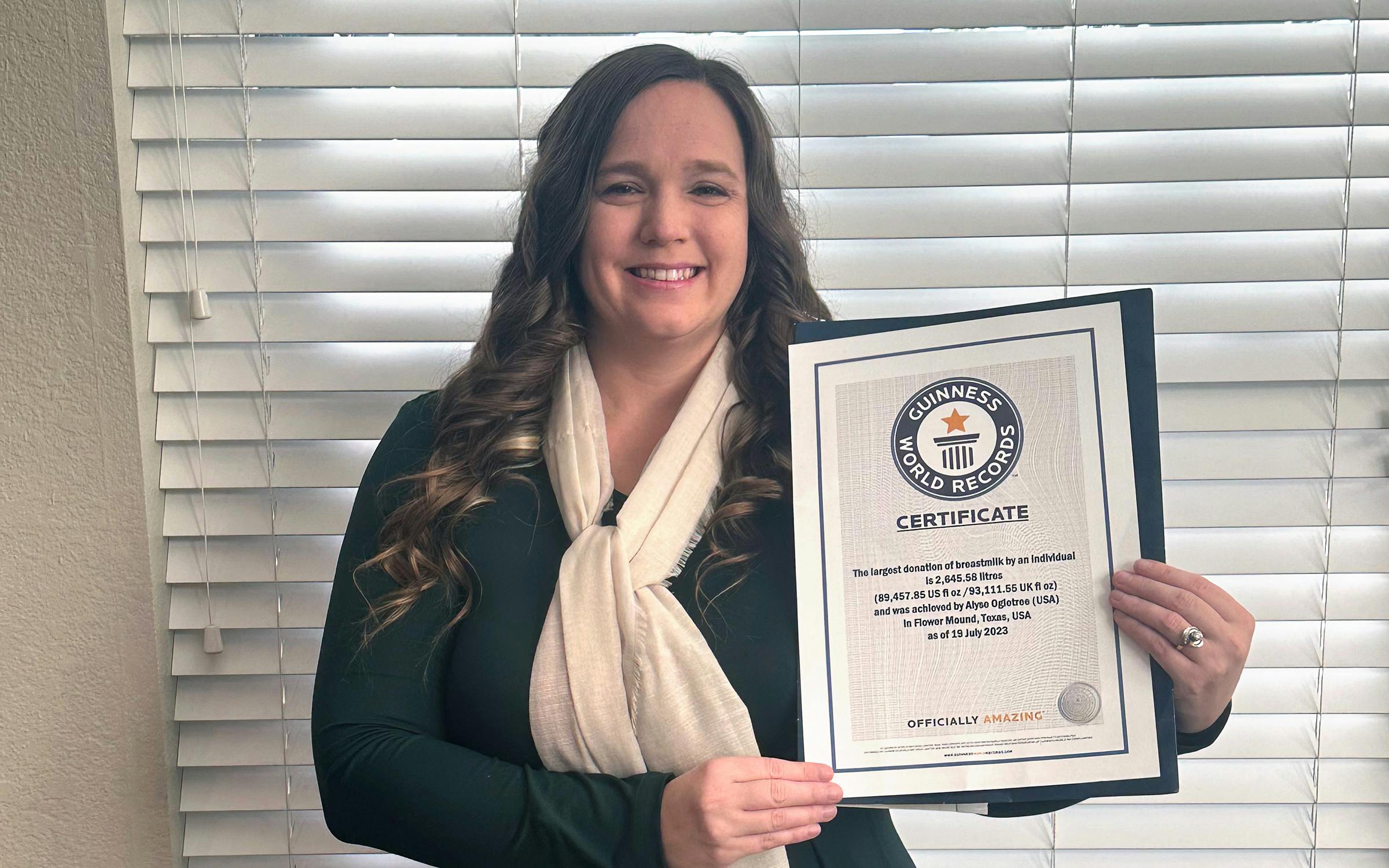WHO: Alyse Ogletree, 36, of Flower Mound.
WHAT: A Guinness World Record–breaking donation of enough breast milk to feed 350,000 babies.
WHY IT’S SO GREAT: Ogletree admits that she’s a “little competitive,” but that may be an understatement. When she heard there was a Guinness World Record for the largest quantity of breast milk donated by an individual, she made a careful plan for how to break it, and then she did just that—twice.
Ogletree’s donation journey started in 2010, when her infant son caught a virus that caused a stroke. She continued to pump milk while he was in the hospital, hoping that she would be able to feed him with it in the following months. A nurse suggested she donate some of the extra to a milk bank. “I didn’t even know donating was a thing,” she said.
A nurse at the hospital connected her with the nonprofit Mothers’ Milk Bank of North Texas. After a brief screening process, Ogletree started leaving frozen bags of breast milk at a drop box at Medical City Lewisville, about twenty minutes from her home in Flower Mound, a suburb northwest of Dallas. Staff tested the milk to ensure that it had plenty of calories and other nutrients before donating it to babies in need. According to the milk bank, three-quarters of donated breast milk is fed to premature babies in neonatal intensive care units. Some is also given to outpatients with medical needs. “Not everybody is going to overproduce like I did, but if anyone is producing more than what they need, there is an opportunity to help others,” Ogletree said. “That’s the beauty about donating to milk banks. They truly cherish every last drop.”
When Ogletree was pregnant with her second child, a daughter, she planned to pump extra milk specifically for those babies in need. “I wanted to donate again, if my body did what it did last time,” she said. “Every person’s body is different and every pregnancy can be different.” During the months before her daughter came into the world, she saw a news story about a woman who made the Guinness Book of World Records for donating breast milk. “I crunched the numbers and thought, ‘I can break that record in, like, two months,’ ” Ogletree said.
The world record is cumulative, meaning Ogletree was able to count the ounces she donated with her first—as long as she didn’t receive compensation for them—and add on any she gave with the second pregnancy. She says she pumped milk for fifteen minutes every three hours “religiously,” even overnight. As many moms know, producing breast milk is demanding physical labor. While she was pumping, she drank 32 ounces of water to stave off dehydration. Then, between each session, she consumed another 32 ounces.
In March 2014, Ogletree submitted paperwork for the world record and obtained it. Between 2011 and 2014, she donated 1,569.79 liters, or in terms many moms who squeeze out every ounce know: 53,081 ounces. She got pregnant again with another son a few years later, and while she did donate some breast milk, she did not overproduce at the same level she did with her second and didn’t need to resubmit a total to retain the record. She held it for several years before it was broken.
Then, two years ago, she carried a pregnancy as a gestational surrogate for another family. Knowing it would be her last pregnancy, she had a goal. She wanted to hit 100,000 total donated ounces—and another world record, of course. So Ogletree continued her strict pumping schedule and was doing well until the family had a car crash. The stress of the event caused her supply to dry up. Still, she had enough to nab the record again in July 2023. The record is for 89,457 ounces donated since 2011, but Ogletree estimates that she’s donated about 37,000 more in total (including donations to Tiny Treasures Milk Bank, in California, and to family and friends). It took about a year for Guinness to process her paperwork. This month, she finally received a certificate that made it official.
Ogletree says the anticipation building up to her first record led to a sense of fulfillment, but she got the most enjoyment from the actual donation process. At a calculation of three babies fed per ounce, she’s donated enough to help approximately 350,000 hungry babies. “It felt good doing something for a good cause,” she said. “Whether you have a lot of extra or a little extra, there are others out there who don’t have enough.”

